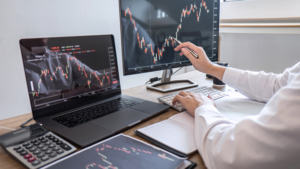Navigating the risks and rewards of auto trading strategies for investors
 For Investors: Where technology intersects with finance more rapidly than ever, the lure of foolproof trading strategies attracts traders of all types. The idea behind ground-breaking auto trading is that computers can execute orders more quickly and in greater amounts than human beings. As a result, it may double your profits. But as with any investment method, it is essential to strip away at all levels and perceptions before you get illusions and hidden dangers in full view.
For Investors: Where technology intersects with finance more rapidly than ever, the lure of foolproof trading strategies attracts traders of all types. The idea behind ground-breaking auto trading is that computers can execute orders more quickly and in greater amounts than human beings. As a result, it may double your profits. But as with any investment method, it is essential to strip away at all levels and perceptions before you get illusions and hidden dangers in full view.
The appeal of autonomy trading
At the heart of auto trading’s attraction is its promise to open up trading to all. With algorithmic trading, investors can take part in old-fashioned stock and futures markets without watching price movements or making telephone calls to place trades. This technology evens things so that even laypeople can deploy professional trading tactics that were earlier outside their means.
When we begin to radiate the “foreign exchange automatic transaction,” complexity and increasing opportunities. Also, with its 24/5 hours of continuous operation, enormous liquidity, and quick price changes, the forex market makes it a perfect location for automatic trading. Algorithms can tirelessly monitor global economic indicators, news, and currency price movements to make trades based on predefined criteria. This relentless and rapid analysis may reveal opportunities not seen or found by humans.
Yet the wily tricks of forex auto trading also pose substantial subtle dangers. While market fluctuations are advantageous for potential profits, they can also amplify losses, especially if positions have been leveraged. Algorithms, no matter how well crafted, are not, after all, every single move in the market, especially those caused by unforeseen geopolitical events or sudden economic changes. Therefore, while automation in forex trading can promote efficiency, it also demands a robust strategy for risk management.
Weighing up the risks
The risks of auto trading extend far beyond market volatility. One of the main ones is that overreliance on technology is dangerous. An adage such as this, “set and forget,” is extremely misleading in terms of auto trading. Algorithms, no matter how advanced, all ultimately operate within the limits they are given by humans. Market conditions are changing, and what used to yield great returns will gradually lose its luster or even come against danger as time passes.
In addition, the very nature of auto trading is digital and introduces many technical risks into the mix. A connection could fail; a software has glitches. Even future threats of cracking may come into it and upset your trades this way, all of which result in potential significant losses. Furthermore, some auto trading platforms are opaque; they do not disclose their strategies in detail. Investors may not fully understand all of the risks they are taking.
Treating the returns with care
A significant portion of the reward disappears as soon as it materializes. Self-directed car traders can take advantage of market imperfections, allowing them to spread out their investment portfolios and achieve returns. The core of automated trading involves comprehension, innovation, and persistence. Those who can clearly grasp their strategies, establish risk thresholds, and consistently fine-tune and adapt their trading approaches based on market conditions will excel. Additionally, it’s essential for individuals to select autopilot trading platforms and software. In addition to criteria, investors require a platform that offers transparency, strong security measures, and customer assistance—not a tool for executing trades.
Indeed, diversifying risk is crucial. Mixing technology with finance enables us to provide trading options to investors at more accessible levels. Still, there are downsides. Unpredictable market swings and tech glitches may impede these goals. Transitioning to automated trading can be beneficial for individuals who prefer a hands-on approach to their investments while incorporating automation.
